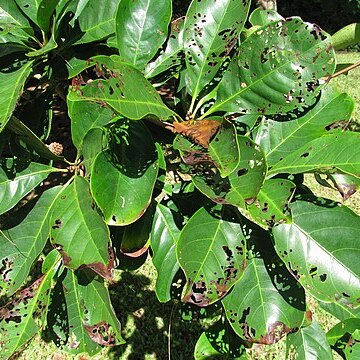Young branchlets at first sericeous appressed-pubescent, soon glabrescent. Leaves chartaceous, spirally arranged along the branchlets, sometimes somewhat crowded towards their tips, sometimes pseudo-whorled, usually glabrous or nearly so, occasionally pubescent on the nerves below, shining above, not verruculose, sometimes rather obscurely verruculose below, obovate, obovate-ellptic or narrowly obovate, 7-12 by 3½-6½ cm, rounded and sometimes acuminate at the apex, cuneate at the base; nerves 6-9 pairs; domatia present but usually not hairy; petiole glabrous or sparsely pubescent, 1-1½ cm, with 2 glands near the apex. Flowers sessile, in axillary spikes 7-10 cm long; rhachis golden-appressed-pubescent. Bracts glabrous or nearly so, filiform, 3-4 mm. Lower receptacle (ovary) usually glabrous rarely sparsely appressed-pubescent, 3-4 mm long; upper receptacle glabrous, shallow-cupuliform, 1 by 3-3½ mm. Calyx-lobes glabrous outside, hairy inside, broadly ovate or deltoid, 2 by 2 mm. Filaments glabrous, 4 mm; anthers 0.8 mm long. Disk barbate. Style glabrous, 4-5 mm. Fruit glabrous ellpsoid, attenuated at each end, often beaked at the apex, 3-5 by 1.8-2 cm, showing in cross-section a ring of sclerenchymatous tissue round the loculus extended radially into 5-6 spoke-like projections with relatively large air-chambers filled with alveolar tissue between them; exocarp rather thick and hard when dried.
More
A large tree that loses most of its leaves at some times. The branches are free from hairs and fairly thick. The leaves are mostly near the ends of twigs. The leaves are smooth and oblong. The flowers are yellowish white. The fruit are oval, hard and heavy. They have a prominent point and are green.


